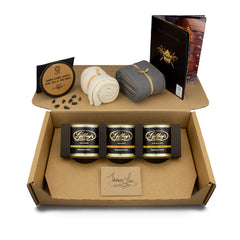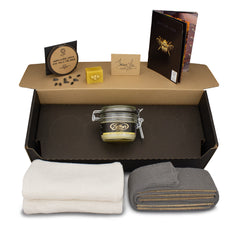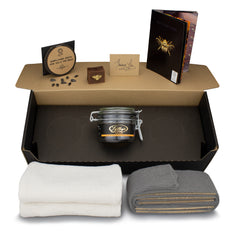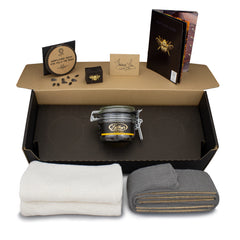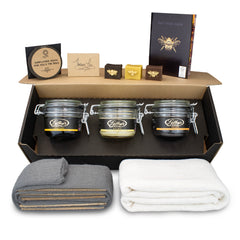ABOUT OUR WAX POLISHES
ETHOS
Our wax polishes were born out of a refusal to accept poor quality products created using cheap ingredients in the name of profit.
Our polishes contain only the highest quality natural waxes, all responsibly sourced. We have a personal relationship with all our bee-keepers and ensure the bees are organically supported and the beeswax is always humanely harvested.
We are a Carbon Negative and Zero Plastic business powered by more energy from the sun than we can currently use.When selecting a polish for your wood, fine antique furniture or leather, we recommend considering the environmental impact of its manufacture and disposal, its effect on indoor air quality, and durability.
"Our intention is not to compete with any other brand,
but to simply make the best beeswax polish we can"
Beeswax has been used for centuries as a water-proof, air-tight protective sealant that helps bring out the natural patina and leaves wood silky-smooth to the touch. That being said, a beeswax polish isn't intended to offer as much protection as lacquers, shellacs, varnishes and oil finishes. It is intended to act as an easily-restored sacrificial layer to protect those expensive and hard-to-repair finishes. A 100% beeswax finish is too soft and wont offer the long term protection, thats's why we blend ours with the hardest of all natural waxes; T1-grade carnauba wax. This is another natural wax, produced by the copernicia cerifera tree to protect its leaves from water, pathogens and UV radiation. As the hardest of all natural waxes with the highest melting point it helps Gilboy's Gold to provide a strong, highly water-resistant and longer-wearing protective finish.
The waxes that make Gilboys polish so special
Pure Beeswax:
Our beeswax is sourced directly from Neil, our local Beekeeper. Neil looks after nearly two hundred and fifty hives within the grounds of Powderham Castle and across the Teign Valley and Dartmoor. Neil employs an organic method of beekeeping so the beeswax produced by his wonderful bees has the most golden colour and is free from pesticides. Neil and his wife Mary personally deliver the beeswax to our workshop. See the bees here: Pure Beeswax:Our beeswax is sourced directly from Neil, our local Beekeeper. Neil looks after nearly two hundred and fifty hives within the grounds of Powderham Castle and across the Teign Valley and Dartmoor. Neil employs an organic method of beekeeping so the beeswax produced by his wonderful bees has the most golden colour and is free from pesticides. Neil and his wife Mary personally deliver the beeswax to our workshop. See the bees here: https://youtu.be/MHYb2Yzd1_Q
Beeswax polish has been used to protect and enhance the finish of wooden furniture for hundreds of years because it helps prevent the wood from drying out while still allowing moisture to move in and out of the wood as humidity changes. Unfortunately there are now many industrial manufacturing businesses making fake, synthetic beeswax which is coloured to look just like real beeswax. If its cheap, it's likely not the real deal.
Carnauba Wax:
One of the hardest natural waxes available. When blended with beeswax it increases both the deep sheen and durability of the polish. Carnauba is non-toxic and food safe. It provides water resistance and makes our polish more resistant to minor scratching than softer wax polishes. Our supplier holds the EcoVadis Platinum Award, the highest sustainability rating, placing them among the top 1% of companies worldwide. https://recognition.ecovadis.com/BnrbiwRE7kKnoHAY3xlCBw
Pure Pine Turpentine:
10 Years ago when Simon first started developing our beeswax polishes he wanted to see if we could move away from the petro-chemical industry. Pure Gum Pine Turpentine has traditionally been used for centuries by craftsmen. It originates from pine trees in the form of a distilled pine resin and is highly compatible with beeswax, allowing it to soften and dissolve the wax with exceptional efficiency. This precise formulation requires less solvent than many other paste wax polishes, ensuring that a greater proportion of Gilboys polish is delivered to the wood, providing a richer, more effective finish.
Unlike petrochemical alternatives, pure turpentine holds much more wax by volume and has a wonderful pine aroma, so we have no need to add synthetic chemical scents. All polishes contain a carrier, or solvent, which preserves the polish in the container and evaporates as it dries. Unfortunately, price pressures in the consumer market have driven most of the major brands of furniture polish to resort to using cheap petrochemical solvents and artificial chemical scents in their wax polishes. Toxic and polluting ingredients such as xylene are common solvents; carcinogens such as arsenic, beryllium, and cadmium are sometimes used as drying agents in linseed oil and toxic glycol ethers may be used as solvents in many water-based sealers. Other polishes may also contain additives to speed drying or provide fungicidal properties. All these elements contribute to a polish's environmental impact.
We source our turpentine from a family-run business located in the Góis region of Portugal who have been operating continuously since 1921. In this company, the transformation of the organically certified natural resin that is tapped from living pines is carried out using the traditional method. Distillation is carried out through steam injection, without the use of reactors and without the addition of chemicals.
They are also founding members of the RN21 initiative, which is developing a Certification Seal to help consumers recognise products with natural, renewable, and sustainable origins, while supporting employment, territorial cohesion, and climate transition across the value chain.

Myrica Wax:
Myrica wax comes from the berries of the bayberry shrub, where it naturally waterproofs and protects seeds from UV damage and weather - properties we harness in our polish. This plant-based wax improves hardness while adding moisture resistance, UV protection, and antimicrobial benefits. Combined with beeswax and carnauba, it creates a protective layer that guards wood surfaces just as it guards seeds in nature, all while keeping the formula natural and sustainable.
Japan Wax/Berry Wax:
Japan wax comes from the fruit peels of sumac trees. Extracted through traditional steaming and pressing, this plant-based wax is softer than our other waxes, improving the polish's spreadability and helping it glide smoothly across wood surfaces. This traditional furniture wax contributes to a natural, even finish.UV Absorber (added in 2024):Simon added an ultraviolet light absorber to the wax formula to help protect the wood and the finish from sun damage. This additive is hazard-free and doesn't affect the polish's performance. After extensive formulation work, samples went to a professional testing lab for rigorous UV radiation testing. Their conclusion: the formulation is "an effective barrier in minimising the effect of UV on wood surfaces."
Polishes vary greatly in their durability and ability to protect wood from heat, water, and chemicals. As restorers of fine antique furniture we have always taken great care to use traditional techniques and the best natural materials we can find. However, in the highly competitive wood polishes market, manufacturers are constantly looking to reduce costs. This inevitably leads to lower quality ingredients being used. The 'recipe' remains the same, but the quality of the polish declines.
After years of trying to find the perfect beeswax polish, we eventually resorted to taking control of the quality by making our own. Using only the finest natural ingredients, our sole aim has always been to make the best beeswax polish possible today.
COVERAGE
Based on a single application on a pre-finished smooth surface finish that is in relatively good condition:
- 125ml Jar will cover approximately 12m² (5 - 6 standard size dining tables)
- 1 litre tin will cover approximately 96-100m² (40 - 48 standard size dining tables)

